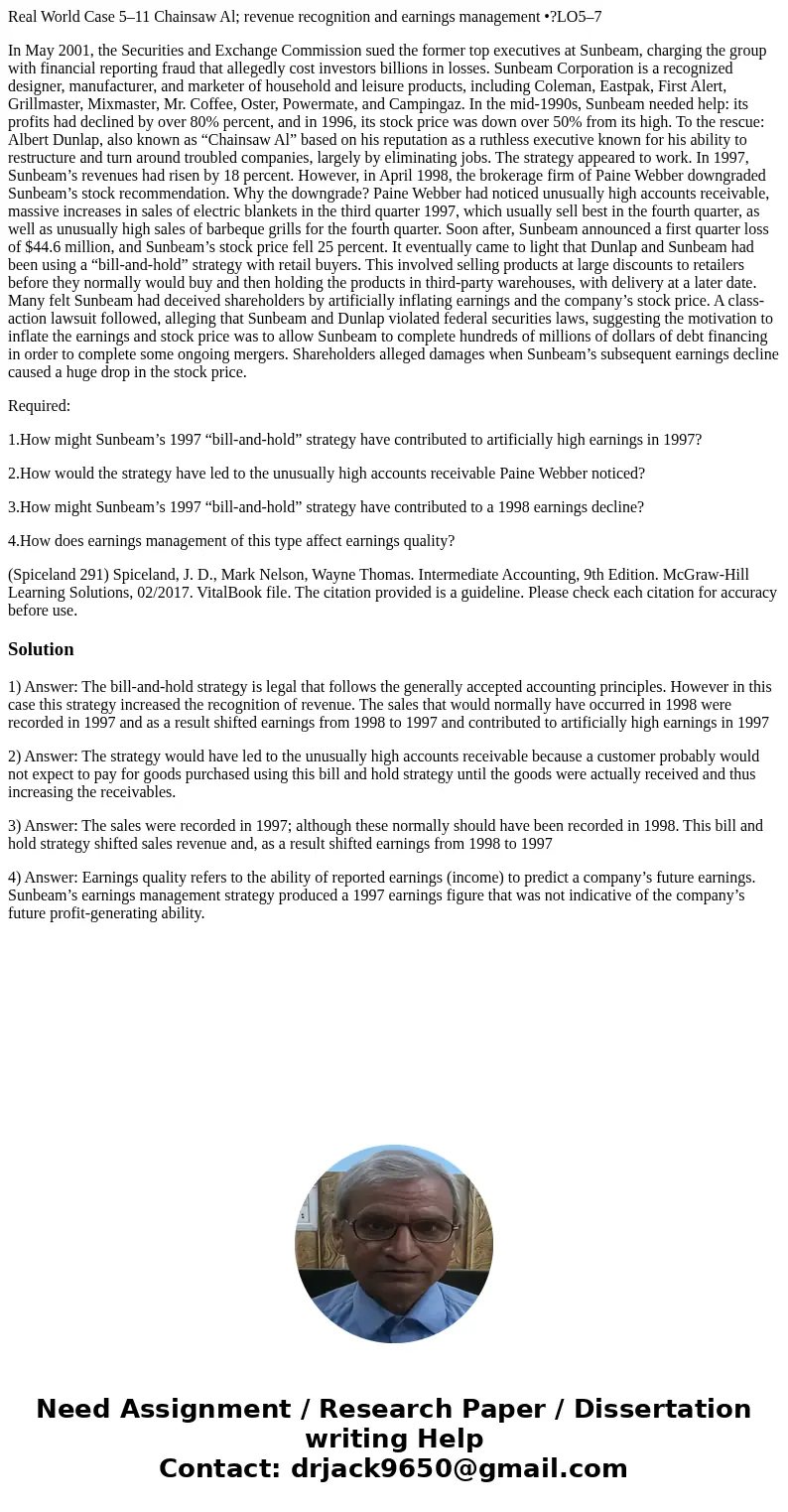Real World Case 511 Chainsaw Al revenue recognition and earn
Real World Case 5–11 Chainsaw Al; revenue recognition and earnings management •?LO5–7
In May 2001, the Securities and Exchange Commission sued the former top executives at Sunbeam, charging the group with financial reporting fraud that allegedly cost investors billions in losses. Sunbeam Corporation is a recognized designer, manufacturer, and marketer of household and leisure products, including Coleman, Eastpak, First Alert, Grillmaster, Mixmaster, Mr. Coffee, Oster, Powermate, and Campingaz. In the mid-1990s, Sunbeam needed help: its profits had declined by over 80% percent, and in 1996, its stock price was down over 50% from its high. To the rescue: Albert Dunlap, also known as “Chainsaw Al” based on his reputation as a ruthless executive known for his ability to restructure and turn around troubled companies, largely by eliminating jobs. The strategy appeared to work. In 1997, Sunbeam’s revenues had risen by 18 percent. However, in April 1998, the brokerage firm of Paine Webber downgraded Sunbeam’s stock recommendation. Why the downgrade? Paine Webber had noticed unusually high accounts receivable, massive increases in sales of electric blankets in the third quarter 1997, which usually sell best in the fourth quarter, as well as unusually high sales of barbeque grills for the fourth quarter. Soon after, Sunbeam announced a first quarter loss of $44.6 million, and Sunbeam’s stock price fell 25 percent. It eventually came to light that Dunlap and Sunbeam had been using a “bill-and-hold” strategy with retail buyers. This involved selling products at large discounts to retailers before they normally would buy and then holding the products in third-party warehouses, with delivery at a later date. Many felt Sunbeam had deceived shareholders by artificially inflating earnings and the company’s stock price. A class-action lawsuit followed, alleging that Sunbeam and Dunlap violated federal securities laws, suggesting the motivation to inflate the earnings and stock price was to allow Sunbeam to complete hundreds of millions of dollars of debt financing in order to complete some ongoing mergers. Shareholders alleged damages when Sunbeam’s subsequent earnings decline caused a huge drop in the stock price.
Required:
1.How might Sunbeam’s 1997 “bill-and-hold” strategy have contributed to artificially high earnings in 1997?
2.How would the strategy have led to the unusually high accounts receivable Paine Webber noticed?
3.How might Sunbeam’s 1997 “bill-and-hold” strategy have contributed to a 1998 earnings decline?
4.How does earnings management of this type affect earnings quality?
(Spiceland 291) Spiceland, J. D., Mark Nelson, Wayne Thomas. Intermediate Accounting, 9th Edition. McGraw-Hill Learning Solutions, 02/2017. VitalBook file. The citation provided is a guideline. Please check each citation for accuracy before use.
Solution
1) Answer: The bill-and-hold strategy is legal that follows the generally accepted accounting principles. However in this case this strategy increased the recognition of revenue. The sales that would normally have occurred in 1998 were recorded in 1997 and as a result shifted earnings from 1998 to 1997 and contributed to artificially high earnings in 1997
2) Answer: The strategy would have led to the unusually high accounts receivable because a customer probably would not expect to pay for goods purchased using this bill and hold strategy until the goods were actually received and thus increasing the receivables.
3) Answer: The sales were recorded in 1997; although these normally should have been recorded in 1998. This bill and hold strategy shifted sales revenue and, as a result shifted earnings from 1998 to 1997
4) Answer: Earnings quality refers to the ability of reported earnings (income) to predict a company’s future earnings. Sunbeam’s earnings management strategy produced a 1997 earnings figure that was not indicative of the company’s future profit-generating ability.

 Homework Sourse
Homework Sourse